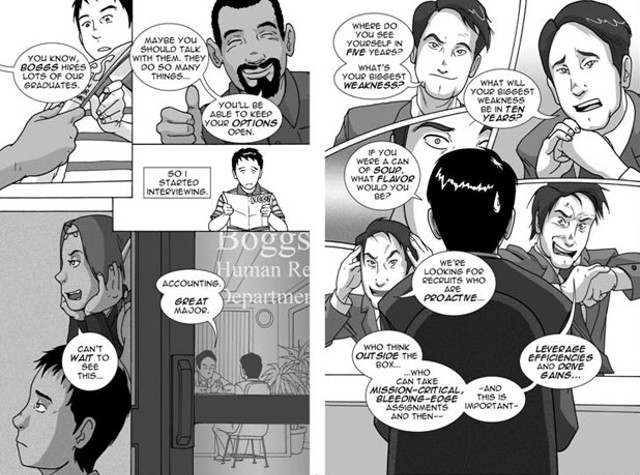Published August 27, 2008 at 5:22 a.m. | Updated September 16, 2016 at 3:27 p.m.
At medical schools all across the country, students are taking time out of their traditional lessons in physiology, pharmacology, pathology and gross anatomy to stroll in art museums. They're studying the composition of classical paintings and learning how the "masters" used light and shadow to convey moods.
These artistic outings are more than just leisurely escapes from the rigors of modern medical training. Elite medical programs such as those at Harvard, Yale, Mount Sinai and UCLA are now using art appreciation to help future doctors dramatically improve their diagnostic skills.
Why? Because good diagnosticians need the observational sensitivity of a painter. In effect, when medical students learn to see the way artists do, they're more likely to notice nuances and subtle changes in the physical conditions of their patients.
Moreover, it's not just medical schools that are rethinking the fundamental skills necessary for success in the 21st century. Business schools, engineering schools and other "hard science" institutions have begun to acknowledge there's more to learning than rote memorization, analytical thinking and high scores on standardized tests.
Will Vermont be ahead of the creative curve? While that remains to be seen, the new pedagogical philosophy took center stage at last week's Champlain Valley Regional Convocation, a first-of-its-kind professional training event held for some 3200 teachers at the Essex Skating Facility in Essex Junction. (Another 1000 or so watched via closed-circuit TV at four remote-viewing areas around the state.) The program was part of a broader, year-long initiative called "Connectivity21," designed to transform schooling and learning in the 21st century.
The jam-packed event was sweltering hot. Featuring a junior ROTC color guard, African drummers and five giant video screens, seemed like a cross between a political rally, a rock concert and a religious tent revival.
The new gospel being preached to Vermont schoolteachers? The future of education lies in developing students' right-brain abilities.
The word comes from Daniel H. Pink, bestselling author of the book A Whole New Mind, which explores the rising dominance of right-brain thinking in the global economy. A number of Vermont school districts purchased copies so teachers could read it beforehand. Many count themselves as enthusiastic apostles. Others see Pink's teaching as merely the field's latest fad.
Pink's got credentials, though not in the field of education. In the 1990s, he was an aide to then-U.S. Labor Secretary Robert Reich and worked as chief speechwriter for then-Vice President Al Gore. Ironically, he's a self-described "extreme left-brain thinker" who confesses to "an unnatural love affair" with numbers, charts and graphs. Pink's career has been about analyzing systems and how they operate. And, lest he be criticized for seeing public education strictly through the eyes of an economist, he readily acknowledges that its mission is not just "to deliver employees to employers," but to help children grow up to become full-fledged participants in civic society.
That orientation makes Pink a convincing spokesman for an alternative approach. He sees the shift from left-brain to right-brain learning as "a metaphor [for the shift] between our past and our children's future." In the last century, he says, the most important skills needed to succeed in the business world entailed the specialties of the brain's left hemisphere - that is, logical, linear, sequential and analytical thinking. These are skills typically associated with people who are strong in math, science, technology and engineering.
Pink isn't saying these skills are no longer necessary in the work force. But he argues that they're no longer sufficient by themselves to ensure young people's success. Today, it's the tendencies more often associated with the right hemisphere of the brain - artistry, creativity, inventiveness, the ability to think "outside the box" and see the "big picture" - that will grow the economy.
Just as machines and automation replaced back-breaking labor in the 20th century, computers are now replacing left-hemisphere labor in the 21st. And in this new world economy, any job that can be routinized to a script, a spec sheet or a series of easily repeatable steps is endangered; it is likely to be automated, computerized or shipped overseas to employees who are willing to do it for a fraction of the cost of their American counterparts. There's no exemption for white-collar professions that have long been considered safe from outsourcing and automation, such as accounting, law and information technology.
To bolster his argument, Pink points to the proliferation of do-it-yourself legal websites for obtaining uncontested divorces - http://www.completecase.com and http://www.123divorceme.com, to name a couple - as well as the growing popularity of business and accounting software as indicators of the trend. Last year, for example, about 1 million Americans had their taxes done by accountants in India, while another 21 million filed their income taxes using TurboTax software.
Pink isn't saying the world would be a better place if only there were more right-minded thinkers in it. Rather, he contends that all professions, even those that traditionally demanded left-brain strengths, are now looking for employees who also demonstrate right-brain abilities.
The bad news, according to Pink: When you look at public education in the United States today, much of it is still based on a 20th-century left-brain model. In short, it is mired in routine: standardized tests, uniform curricula and rote teaching lessons embodying the idea that there's just one right answer to every question. Whether it's the fill-in-the-blanks SATs or No Child Left Behind, educators increasingly face top-down mandates that leave them, and their students, with little time or resources for creative, outside-the-box learning.
The good news, Pink says, is that many of the traditional bastions of left-brain thinking, such as engineering schools and medical colleges, have been embracing right-brain learning for one simple reason: Quantitative evidence suggests it works.
One example: Medical schools have begun teaching empathy to future physicians. According to Pink, the Jefferson Medical College in Philadelphia has devised an objective means of measuring this skill, called the "Jefferson Scale of Physician Empathy." Its research shows that doctors who score higher on the empathy index also have better patient outcomes. This correlation, Pink notes, is a much more reliable indicator of a physician's abilities than his or her MCAT or board scores, which apparently have little or no correlation with patient outcomes.
This trend toward right-brain dominance has also been recognized in the "hard" sciences and the business community. The National Science Board surveyed engineering employers throughout the country and found that what they look for, in addition to strong math and science skills, are people with life experiences, lifelong learning skills, and abilities to innovate, lead, see the bigger picture, and communicate well with others - in short, people who can apply right-brain thinking to left-brain activities.
In many respects, Pink's ideas aren't new - to Vermont's educators or to the business community. For years, academics and economists such as Richard Florida have been touting the growing importance of the "creative economy," the "cultural industries" and "knowledge workers" - architects, writers, designers, software developers, etc. - who fuel business innovation and economic growth.
In fact, for years cities and towns all over Vermont have been embracing this model and seeking strategies to attract and promote a creative workforce as a way to diversify their tax bases and buffer themselves against economic downturns.
Pink's message resonated with many of the teachers who attended his morning presentation.
"All the CEOs and heads of organizations are asking for people who can think outside the box," says Wendy Scott, a Title I teacher at the K-8 Fairfield School who has been in education for 28 years. "And yet, a lot of the emphasis in schools - especially with No Child Left Behind - is all about tests and filling in the blanks."
Scott says she was glad to hear a nationally acclaimed expert talk about the importance of the arts, which are often the first programs to be cut when budgets get tight.
Seventeen-year teaching veteran Steve Crowley says his school - Winooski High - has already done a fair amount of work in the right-brain realm.
"There's a huge pressure today to teach to the test," he says. "As Pink said, the test is about standardization, but our future is about optimization of our human abilities."
Michael Dumont is a co-worker of Crowley's at Winooski High School. He's been in teaching for only three years, but is "pretty fond" of Pink's work, especially his ideas about finding new ways of reaching students outside the traditional educational models.
"I think I'm an example of that," Dumont says. "The old system didn't work for me. I had terrible grades; I'm dyslexic myself. I've never been the type of learner where the books worked."
Tom Emery and his brother Steve come from a long line of teachers, including their mother and three of their siblings. Their father was a principal at Essex High School for many years, and their grandmother taught in a one-room schoolhouse in New Hampshire. For them, Pink's message was right on the money.
"I think it's preaching to the choir in some respects," Tom Emery says, "but it's more ears for the message. It's good to hear people outside the education community looking in and thinking about it."
Tom's brother Steve teaches seventh-grade science in Georgia, Vermont. He says that in his small school of about 600 students, teachers already have plenty of flexibility to teach outside the box in creative ways.
"One of the things I was thinking," he says, "is that this is a great message for community members and the school board to hear - how important it is to be well-rounded and not . . . have everything so scripted."
Not everyone was so taken with Pink's message. Not surprisingly, his critics were also reluctant to be identified by name in print - for fear of getting on the wrong side of administrators. (The Champlain Valley Educational Consortium will be using an online survey to solicit formal feedback from attendees.)
Several detractors make the point that Pink's program, though admirable, will be both difficult and impractical to apply in the classroom. "It all sounds well and good, but we only have seven hours in the day," observes one central Vermont teacher who's been in the classroom for more than 20 years. "How do we get around all our mandates?"
Another longtime educator from northern Vermont notes that, after reading Pink's book and hearing him speak, he was unimpressed. Calling the message "California New Age," he wonders whether Pink's ideas are just the newest fad, "like New Math," making its rounds in the educational circuit.
"After teaching for 30 years, I've seen these things come and go," he says. "If it translates to 'Let's not forget the arts,' then that sounds pretty good to me. But . . . I'm kind of nervous if this translates into a wholesale change of curriculums."
Teaching the Touch-Screen Generation
Last week, a 2-year-old girl named Paige delivered a lesson to thousands of Vermont teachers about the future of public education. Their challenge, which came in the form of a recent YouTube video, showed Paige demonstrating, with astonishing acumen, the various features of the new iPhone. Though this angelic toddler couldn't speak in complete sentences or even spell her own name, she's already a whiz at navigating the palm-sized communications device.
Mike Deweese, superintendent of the Chittenden Central Supervisory Union, used the video to welcome 3200 Vermont educators to a professional development day at the Essex Skating Facility. He noted that Paige is due to enter kindergarten in just three years.
"When Paige enrolls in our schools, how will we teach her?" Deweese asked the assembly. "With what tools will Paige most readily learn? How might we - how must we - adapt to the learning needs of Paige's generation?"
How indeed? Perhaps it was just a coincidence that the soundtrack to the video was Paul Simon's "Kodachrome," which opens with the line, "When I think back on all the crap I learned in high school, it's a wonder I can think at all."
In fact, last Friday's Champlain Valley Regional Convocation was all about how students think and learn. It's part of a larger, year-long initiative called "Connectivity21," designed to transform learning in the 21st century.
Linda Keating is executive director of curriculum, instruction and assessment for Chittenden Central Supervisory Union, which helped organize last week's event. Although professional development programs at the start of the school year aren't a new phenomenon, she says this is the first time they've pulled together teachers from more than a dozen districts and supervisory unions around the state for one daylong event.
What are the goals and expectations attached to Connectivity21? According to Keating, the mantra is "educating students for their future, not our past." This means rethinking teachers' professional development, student assessment and core subjects based on the skills that will be in demand in coming decades.
"The learning opportunities that our kids will have will not be bound by bricks and mortar anymore," Keating adds. "It'll be about who participates in the learning lives of students. It doesn't just have to be the teacher standing at the front of the classroom. It can be a [remote] class in Beijing, or a teacher in Singapore."
At a cost of $20 per head charged to teachers' respective school districts, the daylong convocation is estimated to ring up at about $80,000.
Terence Keating, director of student support services at Essex Town School District, has been in education for 33 years. He understands all too well the challenges of teaching the next generation of students - and may have figured out a low-cost fix: This year, he plans to find an eighth-grader who's willing to spend an hour per week mentoring him on technology.
"They grew up with this stuff and know it more than me," he says. "I realized how much of this stuff I can learn from my kids."
More By This Author
Speaking of...
-

Lt. Gov. Zuckerman Goes on a 'Banned Books Tour'
Sep 6, 2023 -

UVM Hillel Provides Shabbat Meal Kits With Student-Grown Vegetables
Aug 29, 2023 -

Williston Tech Company Polly Lays Off 17 People in Vermont
Dec 5, 2022 -

Heather Moore, New Executive Director of Shelburne Craft School, Is Learning on the Job
Aug 31, 2022 -

Vermont Officials Release Relaxed COVID-19 Guidance for the School Year
Aug 24, 2022 - More »
Comments
Comments are closed.
From 2014-2020, Seven Days allowed readers to comment on all stories posted on our website. While we've appreciated the suggestions and insights, right now Seven Days is prioritizing our core mission — producing high-quality, responsible local journalism — over moderating online debates between readers.
To criticize, correct or praise our reporting, please send us a letter to the editor or send us a tip. We’ll check it out and report the results.
Online comments may return when we have better tech tools for managing them. Thanks for reading.














































